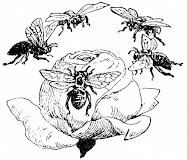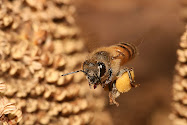
June: A Bee’s Place
This month, let’s focus our attention on the Susquehanna Street site.
If you're new to our blog, take a moment to catch up with previous posts on all the activities that have taken place in the past month: bee curious neighbors came together for a honey tasting party, Westinghouse HS students energized the site with their enthusiastic volunteering, community and city leaders officially inaugurated the site, and the first open apiary at the new location was well attended. Lots of great activity and plenty of buzz!
Not to mention that several hives and many plants are becoming established in the apiary and pollinator garden. While there’s still much work to be done, it’s shaping up to be a great place for bees.
Even in these initial stages we can note several important features that you can use to create your own great bee place. First off, and most noticeably as you approach the site, there’s a solid fence surrounding the apiary that serves multiple functions. It protects the hives from wind and predators. It also forces bees to adjust their flight path upwards to a height where they hopefully won’t be a nuisance to anyone. Such a fence just might be the most important tool for good beekeeping in dense urban areas.
Inside the fence, we can see the hives arranged so that the entrances face south. This helps maximize exposure to the sun’s warmth, particularly in the morning, and revs the bees up for a full day’s work. There’s a water source inside the fence. In our case, it’s a simple large container of water that gets refreshed regularly. Bees generally don’t hover to drink, so it’s important to provide surfaces that they can land on. In this case, we’ve used old wine bottle corks.
There’s also an unintended water source for bees. After heavy rains, the water flows down the slope and onto the asphalt where it forms very shallow pools. It’s pretty cool to watch the bees walk along the ground sipping.
A good water source is perhaps the second most important feature for good urban beekeeping. Around your home, you could also place some rocks in a shallow birdbath or let bees crawl into a spigot set to drip very slowly.
Outside of the fence is the pollinator garden portion of the site. It’s very much a work in progress, more potential than finished product. We’re still building soil to support our castles in the air, and finding out which plants take to the site and which don’t. In other words, we’re learning and the adventure continues.
Hopefully you’ll consider helping bees in your garden by planting some pollinator plants or even just letting the “weeds” flower for a bit. Offer sources of pollen, nectar or water—without using any pesticides—and the bees will come, along with many other beneficial insects.
The last element in our site tour sums up the attitude needed to establish a great place for bees, for pollinator plants, and for visitors:
.JPG)
We’re having this Party, Please Come
…the flowering garden is a place you immediately sense is thick with information, thick as a metropolis, in fact. It’s an oddly sociable, public sort of place, in which species seem eager to give one another the time of day; they dress up, flirt, flit, visit ~
--- Michael Pollan - The Botany of Desire
--- Michael Pollan - The Botany of Desire
Help us celebrate the grand opening of our place for bees on Susquehanna Street! Potluck dish and $5 donation requested, folding chair or blanket recommended. Click on the invite image for a larger view.

Not sure what to say to that social butterfly or shrinking violet at the party that you’d like to meet? Recently flowering plants are always a surefire conversation starter.
Buttercups: I didn’t know that these were good pollinator plants, but a wise elder beek said so. Who am I to go against the word?
Canadian Thistle: Perhaps best appreciated along roadsides or in fictional “rather boggy and sad” places. This is a pretty good pollinator plant, but it sure does take over if you let it. Somewhere, though, I’m sure there’s a hardcore pollinator protector who lets this into the yard on purpose.
Clover (white and red): A life in clover with a field full of bees - can anything be better?
Comfrey: Beloved by permaculturists for its roots that dive deep into the lower soil horizons, and by bumblebees that love its flowers.
Hyacinth: Another great bumblebee plant with lots of bell-shaped flowers. Be careful tossing Frisbees around them, though.
Chives, Raspberries: The edibles mentioned last month have flowered and, in the case of the raspberries, fruited.
Sage: For a couple of days, it seemed like I couldn’t go anywhere without seeing another flowering sage. We live in an abundantly beautiful place.
Lamb’s Ear: This is a fun, tactile plant with tiny purple flowers that bees really go for.
Angelica: While only mildly interesting to bees, angelica nourishes a ton of beneficial insects. Not to mention it’s an ingredient in gin. Cheers!
Catmint: A favorite bee plant in public gardens, these purple flowers last well into the summer.
Coreopsis: Great yellow flowers on top of all that spiky green!
Cornflower or Batchelor’s Button: Vibrant blue flowers that bees like, a perfect boutonniere for the beekeeping prom
~ or apiary grand opening . . . Jeff Irwin
Post your comments to Jeff - and observations on what's UP in your neck of the woods - directly below.
And watch for Jeff's column on the First Sunday of every month.







No comments:
Post a Comment